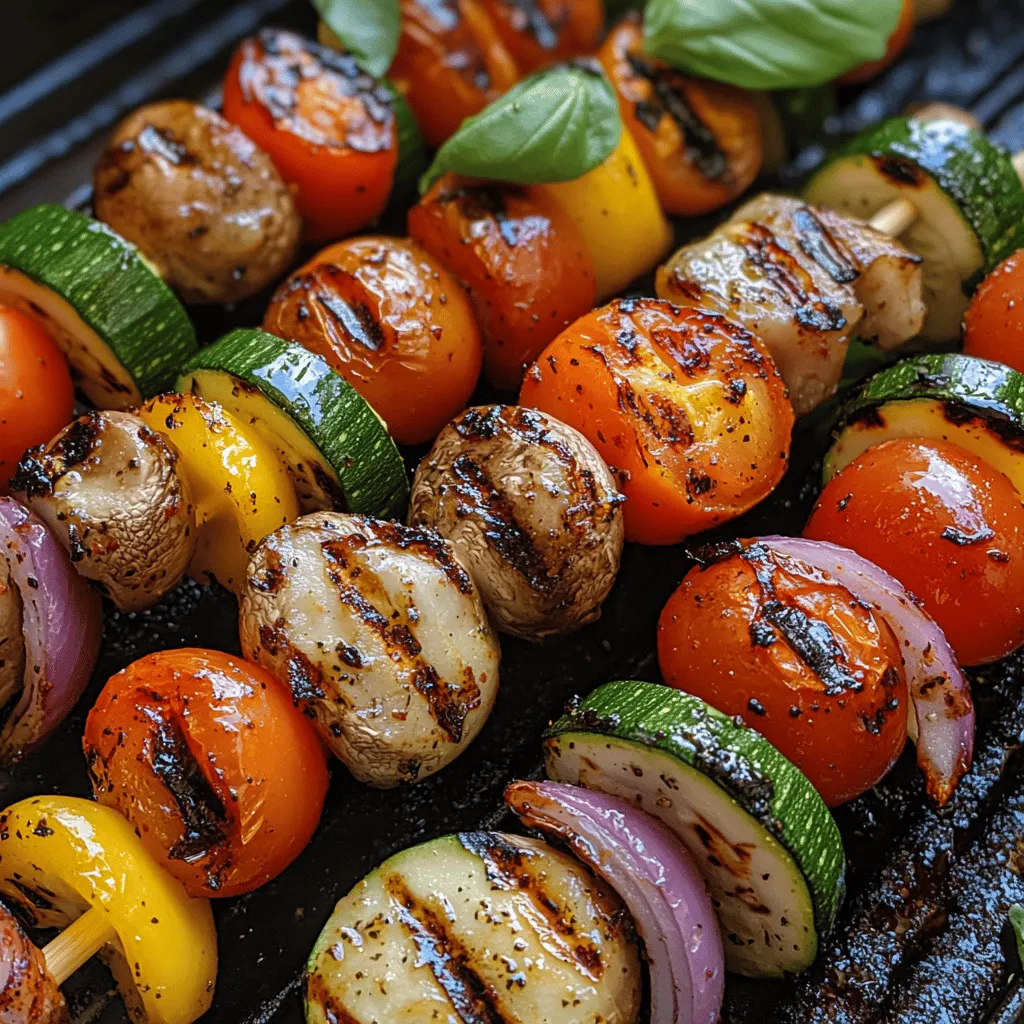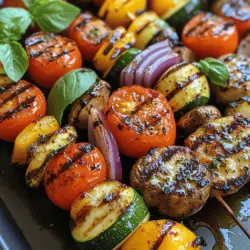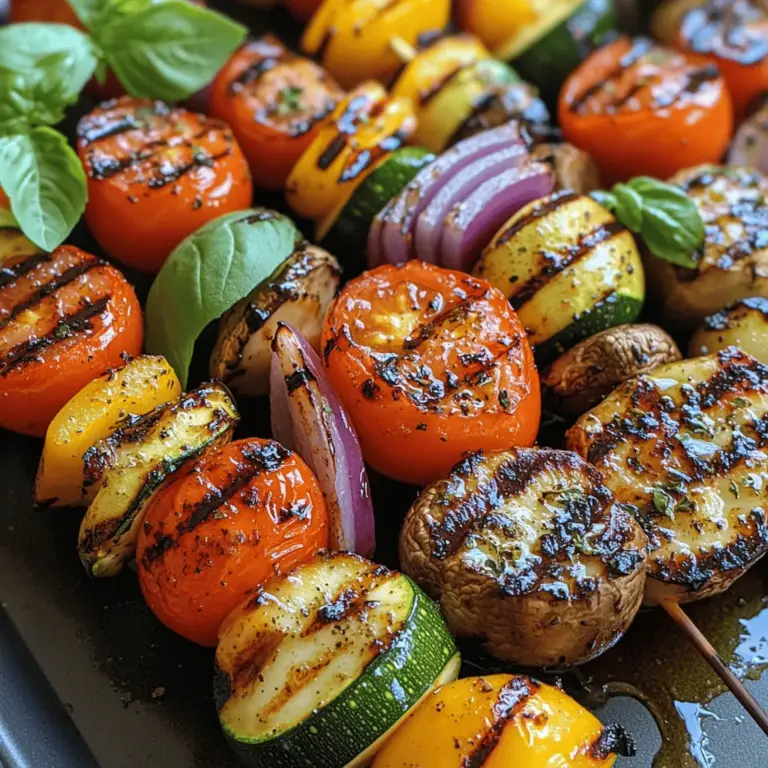Introduction
As the sun shines brighter and the days grow longer, summer gatherings become the perfect occasion to fire up the grill and savor the flavors of the season. Among the many delicious options available for barbecues, colorful grilled veggie skewers stand out as a vibrant and nutritious choice that appeals to both vegetarians and meat lovers alike. These skewers not only add a splash of color to your table but also offer a delightful medley of flavors that are sure to impress your guests.
Grilled vegetables are an excellent way to incorporate more plant-based foods into your diet. They are rich in vitamins, minerals, and antioxidants, making them a healthy addition to any meal. By using a variety of colorful vegetables, you not only enhance the visual appeal of your dishes but also maximize the nutritional benefits. Each vegetable brings its unique taste and health properties, ensuring that every bite is a delightful experience.
This recipe for colorful grilled veggie skewers is incredibly versatile, allowing you to mix and match your favorite vegetables while accommodating dietary preferences. Whether you’re hosting a backyard barbecue, a picnic, or simply looking for a quick weeknight dinner option, these skewers can be customized to suit your taste. With minimal preparation and cooking time, they provide a hassle-free way to enjoy seasonal produce while gathering around the grill with friends and family.
Understanding the Ingredients
To create the perfect grilled veggie skewers, it’s essential to understand the key ingredients that will elevate your dish. Below are the main vegetables featured in this recipe, along with their nutritional benefits and flavor profiles.
Zucchini
Zucchini is a summer squash that is not only versatile but also packed with nutrients. This vegetable is low in calories and high in vitamins A and C, as well as potassium and fiber. The mild flavor of zucchini allows it to absorb marinades well, making it an ideal candidate for grilling. When grilled, zucchini develops a tender texture and a slightly smoky taste that enhances the overall flavor of the skewers.
Bell Peppers
Bell peppers come in a variety of colors, including red, yellow, green, and orange, each offering a unique taste and set of health benefits. For instance, red bell peppers are rich in antioxidants and vitamins A and C, while green peppers are slightly more bitter but still provide significant nutritional value. These vibrant vegetables add a sweet crunch to your skewers and are excellent sources of fiber and folate. When grilled, they become tender and caramelized, intensifying their natural sweetness.
Red Onion
Red onions are often used in grilling for their ability to add depth and flavor to various dishes. They have a milder taste compared to their white or yellow counterparts and become sweeter when grilled. Rich in antioxidants, red onions also boast anti-inflammatory properties and are a good source of vitamins C and B6, along with manganese. Adding chunks of red onion to your skewers enhances the flavor profile, balancing the sweetness of the other vegetables.
Cherry Tomatoes
Sweet and juicy, cherry tomatoes are a delightful addition to any skewer. They are packed with vitamins C and K, potassium, and antioxidants like lycopene, which is thought to promote heart health. Grilling cherry tomatoes brings out their natural sweetness and creates a burst of flavor in every bite. Their vibrant red color not only adds visual appeal but also contributes valuable nutrients to the dish.
Mushrooms
Mushrooms are a fantastic source of umami flavor, making them a popular choice for grilling. Varieties such as cremini, shiitake, or portobello all bring unique textures and tastes to your skewers. Rich in B vitamins, selenium, and antioxidants, mushrooms are low in calories and fat, making them a healthy ingredient. When grilled, they become tender and juicy, absorbing the flavors of the marinade beautifully.
The Role of the Marinade
The marinade is a crucial component of any grilled dish, as it adds flavor and moisture to the vegetables while also enhancing their natural tastes. For this recipe, we will create a simple yet flavorful marinade that consists of olive oil, balsamic vinegar, and a blend of spices and herbs.
Olive Oil
Olive oil is not only a flavorful base for our marinade but also offers numerous health benefits. It is rich in monounsaturated fats, which are known to promote heart health, and contains antioxidants that may help reduce inflammation. Additionally, olive oil helps vegetables retain moisture during grilling, preventing them from becoming dry.
Balsamic Vinegar
Balsamic vinegar adds depth and acidity to the marinade, balancing the flavors of the vegetables. It has a slightly sweet taste and is rich in antioxidants, which can help improve heart health. The acidity of balsamic vinegar also aids in tenderizing the vegetables, making them more enjoyable to eat.
Spices and Herbs
To elevate the flavor of our grilled veggie skewers, we’ll incorporate a blend of spices and herbs. Garlic powder adds a savory depth, while oregano contributes a warm, earthy note. Smoked paprika lends a subtle smokiness that perfectly complements the grilling process, giving the skewers an irresistible flavor profile.
Preparation Steps Explained
Now that we’ve explored the ingredients and their benefits, it’s time to dive into the preparation process. Following these detailed steps will ensure that your colorful grilled veggie skewers turn out perfectly every time.
Detailed Guidance on Prepping the Vegetables
1. Select Fresh Produce: Start with fresh, vibrant vegetables. Choose organic when possible to maximize flavor and nutrition. Look for firm zucchini, bright bell peppers, plump cherry tomatoes, and fresh mushrooms.
2. Wash and Dry: Thoroughly wash all the vegetables under cold running water to remove any dirt or pesticides. Pat them dry with a clean kitchen towel or paper towels.
3. Cutting the Vegetables:
– Zucchini: Slice the zucchini into thick rounds or half-moons, about 1-inch thick. This size will ensure they hold up well on the skewers and grill evenly.
– Bell Peppers: Remove the stem and seeds, then cut the bell peppers into large squares or rectangles, approximately 1-2 inches in size. This size allows them to cook through without becoming too soft.
– Red Onion: Cut the red onion into wedges, keeping the layers intact for easier threading onto the skewers. Aim for 1-2 inch pieces to match the size of the other vegetables.
– Cherry Tomatoes: Simply leave the cherry tomatoes whole; their small size makes them perfect for skewering without any cutting.
– Mushrooms: Depending on the size, you can leave small mushrooms whole or slice larger ones in half. Ensure all mushroom pieces are similar in size to promote even cooking.
Marinade Creation and Tips for Maximizing Flavor Absorption
1. Combine Ingredients: In a large mixing bowl, whisk together olive oil, balsamic vinegar, garlic powder, oregano, and smoked paprika. Adjust the proportions to suit your taste preference.
2. Add Vegetables: Once the marinade is well mixed, add all the prepared vegetables to the bowl. Gently toss the vegetables in the marinade, ensuring they are evenly coated.
3. Marinating Time: For the best flavor, allow the vegetables to marinate for at least 30 minutes at room temperature. If you have more time, consider marinating them for up to 2 hours in the refrigerator. This will help the flavors penetrate the veggies, making them more delicious once grilled.
Suggestions for Customization
Feel free to customize your skewers by adding other vegetables or spices based on your preferences and what’s in season. Here are a few ideas to enhance your grilled veggie skewers:
– Additional Vegetables: Consider adding asparagus, eggplant, or even cubes of firm tofu for added protein.
– Herbs: Fresh herbs such as thyme, rosemary, or basil can be used in place of or in addition to dried herbs for a fresher flavor.
– Spices: Experiment with different spice blends or add a pinch of chili flakes for a bit of heat.
By following these guidelines and understanding the ingredients, you’ll be well on your way to creating a stunning and delicious dish that will impress everyone at your summer barbecue. Stay tuned for the next part, where we’ll explore the grilling process and tips for achieving that perfect char on your colorful veggie skewers.

Skewering Techniques
When it comes to creating colorful grilled veggie skewers, proper skewering techniques play a vital role in both presentation and cooking. Here are some best practices to ensure your skewers are not only visually appealing but also easy to handle during the grilling process.
Best Practices for Threading Vegetables onto Skewers
1. Choose the Right Skewers: Whether you opt for wooden or metal skewers, ensure they are sturdy enough to hold the weight of the vegetables. If you choose wooden skewers, soak them in water for at least 30 minutes before using to prevent them from burning on the grill.
2. Cut Uniform Sizes: To ensure even cooking, cut your vegetables into uniform sizes. Smaller pieces will cook faster, while larger chunks may need more time. A good rule of thumb is to cut vegetables into 1 to 1.5-inch pieces.
3. Thread with Care: When threading vegetables onto skewers, start with denser vegetables like bell peppers and zucchini, and finish with softer ones like cherry tomatoes or mushrooms. This layering technique helps to balance the cooking times.
Alternating Colors and Types for Aesthetic Appeal
An eye-catching presentation can make your skewers stand out. Alternate between different types of vegetables and colors to create a rainbow effect. For instance, you might layer red bell peppers, yellow zucchini, green bell peppers, and purple onion. Not only does this enhance the visual appeal, but it also creates a delightful medley of flavors.
Safety Tips for Handling Skewers
– Wooden vs. Metal: Wooden skewers are lightweight and inexpensive but require soaking to prevent burning. Metal skewers are reusable and can withstand high temperatures without charring, but they can become very hot, so always use tongs or oven mitts when handling them.
– Keep a Safe Distance: When grilling, maintain a safe distance from the grill to avoid burns. Use long-handled tongs to maneuver skewers on the grill, which allows for a safe cooking experience.
Grilling Process
The grilling process is crucial for achieving perfectly cooked veggie skewers. Here’s how to master the art of grilling:
Preheating the Grill: Importance of Temperature Control
Before grilling, preheat your grill to medium-high heat (about 400-450°F). Preheating ensures that your vegetables cook evenly and develop beautiful grill marks. A hot grill also helps to sear the vegetables, locking in flavors and moisture.
Cooking Times and Techniques for Perfect Grill Marks
Grill your veggie skewers for about 10-15 minutes, turning them every few minutes to achieve even cooking and those coveted grill marks. The key is to avoid overcrowding the skewers; this allows for proper air circulation and ensures that every piece gets that delicious char.
Tips for Turning Skewers Without Losing Vegetables
To turn your skewers without losing any veggies, use a pair of long-handled tongs rather than a fork. Forks can pierce through delicate vegetables, causing them to fall off. Instead, grip the skewer firmly with the tongs and gently rotate it to turn.
Recognizing When the Vegetables Are Done
You’ll know your skewers are done when the vegetables are tender and have attractive char marks. Bell peppers should be slightly softened, zucchini should be tender yet firm, and mushrooms should be juicy. Keep in mind that overcooking can lead to mushy veggies, so check them periodically while grilling.
Serving Suggestions
Once your colorful grilled veggie skewers are ready, it’s time to think about presentation and pairing ideas.
Creative Ways to Serve Grilled Veggie Skewers
Serve the skewers directly off the grill or transfer them to a serving platter. You can also place them vertically in a glass or jar for a fun, rustic presentation. Drizzle with olive oil or a squeeze of lemon just before serving to enhance the flavors.
Pairing Ideas (Dips, Sauces, or Sides)
Grilled veggie skewers pair beautifully with a variety of dips and sauces. Consider serving them with:
– Hummus: A creamy option that complements the smoky flavors of the vegetables.
– Tzatziki: This yogurt-based sauce adds a refreshing touch.
– Chimichurri: A vibrant herb sauce that brings a zesty kick.
In addition to dips, you can serve the skewers alongside grilled proteins like chicken or fish, or complement them with a light salad or quinoa for a complete meal.
Serving as an Appetizer Versus a Side Dish
Grilled veggie skewers can be versatile; they make an excellent appetizer, especially when served with an array of dips. Alternatively, they can be a delightful side dish at a barbecue or picnic, enhancing the main course with their colorful and healthy presence.
Presentation Tips for a Visually Appealing Dish
For an impressive presentation, layer your skewers on a large platter, garnishing with fresh herbs like parsley or cilantro. You can also sprinkle some sesame seeds or feta cheese for an added touch. A colorful table setting with fresh vegetables and herbs can complement your grilled skewers beautifully.
Nutritional Benefits of Grilled Veggies
Grilled veggie skewers not only taste amazing but also offer numerous health benefits, making them an excellent addition to any meal.
Overview of the Health Benefits of a Plant-Based Diet
Incorporating more plant-based foods into your diet can lead to a range of health benefits, including improved heart health, better digestion, and enhanced energy levels. Vegetables are rich in vitamins, minerals, and antioxidants, which can help reduce the risk of chronic diseases.
Nutritional Breakdown of the Ingredients Used
The vegetables typically used in grilled skewers, such as bell peppers, zucchini, onions, and mushrooms, are low in calories and high in essential nutrients. For example:
– Bell Peppers: High in vitamin C and antioxidants.
– Zucchini: Low in calories and a good source of potassium.
– Mushrooms: Rich in B vitamins and selenium.
By grilling these vegetables, you retain their nutrients while enhancing their natural flavors without adding excessive calories.
How Grilling Enhances Flavor Without Added Calories
Grilling vegetables brings out their natural sweetness and adds a smoky flavor without the need for heavy marinades or sauces. This method of cooking allows you to enjoy the rich taste of vegetables while keeping the dish light and healthy.
Conclusion
Colorful grilled veggie skewers are not just a feast for the eyes; they are a celebration of vibrant flavors and essential nutrients. They offer a simple yet elegant way to incorporate more vegetables into your diet, making them perfect for summer cookouts or any gathering.
By experimenting with different vegetables and marinades, you can create endless variations of this recipe, ensuring that it never becomes boring. Whether you choose to serve them as an appetizer, side dish, or main course, grilled veggie skewers are bound to impress your guests and elevate your outdoor dining experience.
Make grilled veggie skewers a staple in your summer cooking repertoire, and enjoy the delightful flavors, vibrant colors, and numerous health benefits they bring to your table. Embrace the art of grilling and let your creativity shine through with every skewered bite!


